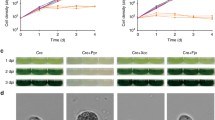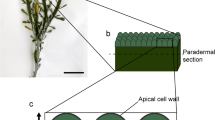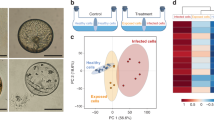Abstract
During the first day of development, fertilized eggs of fucoid algae generate an embryonic axis and commence rhizoid growth at one pole. Using Fucus distichus (L.) Powell, F. vesiculosus L. and Pelvetia fastigiata (J.Ag.) DeTony we have investigated the role of calcium in axis formation and fixation as well as in tip growth. The intracellular distribution of membrane-associated calcium was visualized with the fluorescent calcium probe chlorotetracycline (CTC). Punctate fluorescence associated with organelle-like structures was found in conjunction with diffuse staining at all developmental stages. This membrane-associated calcium remained uniformly distributed throughout the cortical cytoplasm while the axis was established, but increased in the rhizoid protuberance at germination. In subsequent development, fluorescence was restricted to the cortical cytoplasm at the elongating tip and at sites of crosswall biosynthesis.
The requirement for Ca2+ uptake during development was investigated through inhibition studies; influx was impaired with transport antagonists or by removal of extracellular calcium. Both treatments curtailed germination and tip elongation but had little effect on axis polarization. Reductions in external calcium that interfered with elongation also markedly reduced the apical CTC fluorescencence, indicating that calcium uptake and localization are prerequisites for tip growth. This apical Ca2+ is probably involved in the secretory process that sustains tip elongation. By contrast, calcium was not implicated in the generation of an embryonic axis.
Similar content being viewed by others
Abbreviations
- ASW:
-
artificial seawater
- CTC:
-
chlorotetracycline
- DU:
-
developmental unit
- EGTA:
-
erhylene glycol bis(amino-ethyl ether) N,N,N1,N1−tetraacetic acid
- NPN:
-
N-phenyl-1-napthylamine
References
Ballard, S.G., Barker, R.W., Barrett Bee, K.J., Dwak, R.A., Radda, G.K., Smith, D.S., Taylor, J.A. (1972) The location and response of probes in membranes. In: Biochemistry and biophysics of mitochondrial membranes, pp. 257–275, Azzone, G.F., Carafoli, E., Lehniger, A.L., Quagliariello, E., Siliprandi, N., eds. Academic Press, New York London
Blinks, J.R., Wier, W.G., Hess, P., Prendergast, F.G. (1982) Measurement of Ca2+ concentrations in living cells. Progr. Biophys. Molec. Biol. 40, 10–114
Brawley, S.H., Quatrano, R.S. (1979) Sulfation of fucoidin in Fucus embryos. IV. Autoradiographic investigations of fucoidin sulfation and secretion during differentiation and the effect of cytochalasin treatment. Devel. Biol. 73, 193–205
Brawley, S.H., Robinson, K.R. (1985) Cytochalsasin treatment disrupts the endogenous currents associated with cell polarization in fucoid zygotes: studies of the role of F-actin in embryogenesis. J. Cell Biol. 100, 1173–1184
Brownlee, C., Wood, J.W. (1986) A gradient of cytoplasmic free calcium in growing rhizoid cells of Fucus serratus. Nature 320, 624–626
Caldwell, P.C. (1970) Calcium chelators and buffers. In: Calcium and cellular function, pp. 10–16, Cuthbert, A.W., ed. St. Martins Press, New York
Caswell, A. (1979) Methods for measuring intracellular calcium. Int. Rev. Cytol. 56, 145–181
Churchill, P.C., McDonald, F.D., Churchill, M.C. (1981) Effect of diltiazem, a calcium antagonist, on renin secretion from rat kidney slices. Life Sci. 19, 383–389
Gilkey, J.C., Jaffe, L.F. (1976) Gradients of calcium ion concentration within Pelvetia fastigiata embryos. (Abstr.) Biophys. J. 16, 110a
Hausser, I., Herth, W. (1983) The Ca2+−chelating antibiotic, chlorotetracycline (CTC), disturbs multipolar tip growth and primary wall formation in Micrasterias. Protoplasma 117, 167–173
Heslop-Harrison, J.S., Heslop-Harrison, J., Heslop-Harrison, Y., Reger, B.J. (1985) The distribution of calcium in the grass pollen tube. Proc. R. Soc. London B Ser. 225, 315–327
Jaffe, L.A., Weisenseel, M.H., Haffe, L.F. (1975) Calcium accumulations within the growing tips of pollen tubes. J. Cell Biol. 67, 488–492
Jaffe, L.F. (1954) Stimulation of the discharge of gametangia from a brown alga by a change from light to dark. Nature 174, 743.
Jaffe, L.F. (1968) Localization in the developing Fucus egg and the general role of localizing currents. Adv. Morphog. 7, 295–328
Martin, R.B., Richardson, F.S. (1979) Lanthanides as probes for calcium in biological systems. Quart. Rev. Biophys. 12, 181–209
Meindl, U. (1982) Local accumulation of membrane-associated calcium according to cell pattern formation in Micrasterias denticulata, visualized by chlorotetracycline fluorescence. Protoplasma 110, 143–146
Miller, C., White, M.M. (1984) Dimeric structure of single chloride channels from Torpedo electroplax. Proc. Natl. Acad. Sci. USA 81, 2772–2775
Nuccitelli, R. (1978) Ooplasmic segregation and secretion in the Pelvetia egg is accompanied by a membrane-generated electrical current. Devel. Biol. 62, 13–33
Picton, J.M., Steer, M.W. (1982) A model for the mechanism of tip extension in pollen tubes. J. Theor. Biol. 98, 15–20
Picton, J.M., Steer, M.W. (1983) Evidence for the role of Ca2+ ions in tip extension in pollen tubes. Protoplasma 115, 11–17
Quatrano, R.S. (1973) Separation of processes associated with differentiation of two-celled Fucus embryos. Devel. Biol. 30, 209–213
Quatrano, R.S. (1978) Development of cell polarity. Ann. Rev. Plant Physiol. 29, 487–506
Quatrano, R.S. (1980) Gamete release, fertilization, and embryogenesis in the fucales. In: Handbook of phycological methods: developmental and cytological methods, pp. 59–68, Gantt, E., ed. Cambridge University Press, Cambridge, UK
Quatrano, R.S., Brawley, S.H., Hogsett, W.E. (1979) The control of the polar deposition of a sulfated polysaccharide in Fucus zygotes. In: Determinants of spatial organization, pp. 77–96, Subtelny, S., Konigsberg, I.R., eds. Academic Press, NY
Quatrano, R.S., Griffing, L.R., Huber-Walchli, V., Doubet, S. (1985) Cytological and biochemical requirements for the establishment of a polar cell. J. Cell Sci., Suppl. 2, 129–141
Reiss, H.D., Grime, G.W., Li, M.Q., Takacs, J., Watt, F. (1985) Distribution of elements in the lily pollen tube tip, determined with the Oxford scanning proton microprobe. Protoplasma 126, 147–152
Reiss, H.D., Herth, W. (1979) Calcium gradients in tip growing plant cells visualized by chlorotetracycline fluorescence. Planta 146, 615–621
Reiss, H.D., Herth, W., Schnepf, E., Nobiling, R. (1983) The tip-to-base calcium gradient in pollen tubes of Lilium longiflorum measured by proton-induced X-ray emission (PIXE). Protoplasma 225, 153–159
Robinson, K.R. (1977) Redticed external calcium or sodium stimulates calcium influx in Pelvetia eggs. Planta 136, 153–158
Robinson, K.R., Cone, R. (1980) Polarization of fucoid eggs by a calcium ionophore gradient. Science 207, 77–78
Robinson, K.R., Jaffe, L.F. (1975) Polarizing fucoid eggs drive a calcium current through themselves. Science 187, 70–72
Robinson, K.R., Jaffe, L.F. (1976) Calcium gradients and egg polarity. (Abstr.) J. Cell Biol. 70, 37a
Saunders, M.J., Hepler, P.K. (1981) Localization of membraneassociated calcium following cytokinin treatment in Funaria using chlorotetracylcine. Planta 152, 272–281
Thomas, M.V. (1982) Techniques in calcium research. Academic Press, New York
Triggle, D.J. (1981) Calcium antagonists: Basic chemical and pharmacological aspects. In: New perspectives in calcium antagonists, pp. 1–18, Weiss, G., ed. American Physiological Society, Bethesda, Md., USA
Weisenseel, M.H., Jaffe, L.F. (1972) Membrane potential and impedance of developing fucoid eggs. Devel. Biol. 27, 555–574
Author information
Authors and Affiliations
Rights and permissions
About this article
Cite this article
Kropf, D.L., Quatrano, R.S. Localization of membrane-associated calcium during development of fucoid algae using chlorotetracycline. Planta 171, 158–170 (1987). https://doi.org/10.1007/BF00391091
Received:
Accepted:
Issue Date:
DOI: https://doi.org/10.1007/BF00391091




